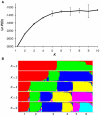Worldwide genetic variability of the Duffy binding protein: insights into Plasmodium vivax vaccine development
- PMID: 21829672
- PMCID: PMC3149059
- DOI: 10.1371/journal.pone.0022944
Worldwide genetic variability of the Duffy binding protein: insights into Plasmodium vivax vaccine development
Abstract
The dependence of Plasmodium vivax on invasion mediated by Duffy binding protein (DBP) makes this protein a prime candidate for development of a vaccine. However, the development of a DBP-based vaccine might be hampered by the high variability of the protein ligand (DBP(II)), known to bias the immune response toward a specific DBP variant. Here, the hypothesis being investigated is that the analysis of the worldwide DBP(II) sequences will allow us to determine the minimum number of haplotypes (MNH) to be included in a DBP-based vaccine of broad coverage. For that, all DBP(II) sequences available were compiled and MNH was based on the most frequent nonsynonymous single nucleotide polymorphisms, the majority mapped on B and T cell epitopes. A preliminary analysis of DBP(II) genetic diversity from eight malaria-endemic countries estimated that a number between two to six DBP haplotypes (17 in total) would target at least 50% of parasite population circulating in each endemic region. Aiming to avoid region-specific haplotypes, we next analyzed the MNH that broadly cover worldwide parasite population. The results demonstrated that seven haplotypes would be required to cover around 60% of DBP(II) sequences available. Trying to validate these selected haplotypes per country, we found that five out of the eight countries will be covered by the MNH (67% of parasite populations, range 48-84%). In addition, to identify related subgroups of DBP(II) sequences we used a Bayesian clustering algorithm. The algorithm grouped all DBP(II) sequences in six populations that were independent of geographic origin, with ancestral populations present in different proportions in each country. In conclusion, in this first attempt to undertake a global analysis about DBP(II) variability, the results suggest that the development of DBP-based vaccine should consider multi-haplotype strategies; otherwise a putative P. vivax vaccine may not target some parasite populations.
Conflict of interest statement
Figures




Similar articles
-
Immunogenicity of single versus mixed allele vaccines of Plasmodium vivax Duffy binding protein region II.Vaccine. 2013 Sep 13;31(40):4382-8. doi: 10.1016/j.vaccine.2013.07.002. Epub 2013 Jul 31. Vaccine. 2013. PMID: 23916294 Free PMC article.
-
Non-allele specific antibody responses to genetically distinct variant forms of Plasmodium vivax Duffy binding protein (PvDBP-II) in Iranians exposed to seasonal malaria transmission.Acta Trop. 2014 Aug;136:89-100. doi: 10.1016/j.actatropica.2014.03.019. Epub 2014 Apr 2. Acta Trop. 2014. PMID: 24704284
-
Diversity pattern of Duffy binding protein sequence among Duffy-negatives and Duffy-positives in Sudan.Malar J. 2018 Aug 17;17(1):297. doi: 10.1186/s12936-018-2425-z. Malar J. 2018. PMID: 30119671 Free PMC article.
-
Finding the sweet spots of inhibition: understanding the targets of a functional antibody against Plasmodium vivax Duffy binding protein.Int J Parasitol. 2012 Nov;42(12):1055-62. doi: 10.1016/j.ijpara.2012.09.006. Epub 2012 Oct 12. Int J Parasitol. 2012. PMID: 23068913 Free PMC article. Review.
-
The Duffy binding protein as a key target for a Plasmodium vivax vaccine: lessons from the Brazilian Amazon.Mem Inst Oswaldo Cruz. 2014 Aug;109(5):608-17. doi: 10.1590/0074-0276130592. Mem Inst Oswaldo Cruz. 2014. PMID: 25185002 Free PMC article. Review.
Cited by
-
Genetic diversity and population structure of genes encoding vaccine candidate antigens of Plasmodium vivax.Malar J. 2012 Mar 14;11:68. doi: 10.1186/1475-2875-11-68. Malar J. 2012. PMID: 22417572 Free PMC article.
-
Red blood cell invasion by Plasmodium vivax: structural basis for DBP engagement of DARC.PLoS Pathog. 2014 Jan;10(1):e1003869. doi: 10.1371/journal.ppat.1003869. Epub 2014 Jan 9. PLoS Pathog. 2014. PMID: 24415938 Free PMC article.
-
Molecular Evolution of PvMSP3α Block II in Plasmodium vivax from Diverse Geographic Origins.PLoS One. 2015 Aug 12;10(8):e0135396. doi: 10.1371/journal.pone.0135396. eCollection 2015. PLoS One. 2015. PMID: 26266539 Free PMC article.
-
Dynamics of IgM and IgG responses to the next generation of engineered Duffy binding protein II immunogen: Strain-specific and strain-transcending immune responses over a nine-year period.PLoS One. 2020 May 7;15(5):e0232786. doi: 10.1371/journal.pone.0232786. eCollection 2020. PLoS One. 2020. PMID: 32379804 Free PMC article.
-
Extensive genetic diversity of Plasmodium vivax dbp-II in Rio de Janeiro Atlantic Forest and Brazilian Amazon Basin: evidence of positive selection.Malar J. 2020 Feb 19;19(1):81. doi: 10.1186/s12936-020-03159-y. Malar J. 2020. PMID: 32075659 Free PMC article.
References
-
- Mendis K, Sina BJ, Marchesini P, Carter R. The neglected burden of Plasmodium vivax malaria. Am J Trop Med Hyg. 2001;64:97–106. - PubMed
-
- Price RN, Douglas NM, Anstey NM. New developments in Plasmodium vivax malaria: severe disease and the rise of chloroquine resistance. Curr Opin Infect Dis. 2009;22:430–435. - PubMed
Publication types
MeSH terms
Substances
LinkOut - more resources
Full Text Sources

